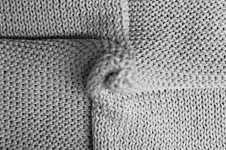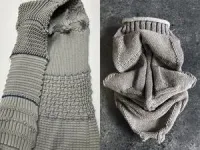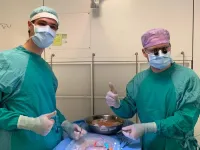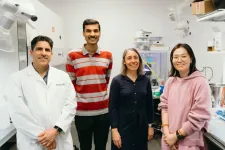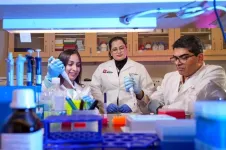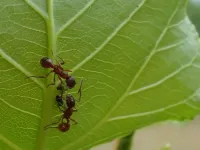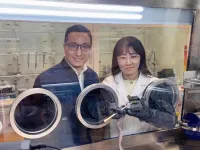(Press-News.org) The practice of purposely looping thread to create intricate knit garments and blankets has existed for millennia. Though its precise origins have been lost to history, artifacts like a pair of wool socks from ancient Egypt suggest it dates back as early as the 3rd to 5th century CE. Yet, for all its long-standing ubiquity, the physics behind knitting remains surprisingly elusive.
“Knitting is one of those weird, seemingly simple but deceptively complex things we take for granted,” says theoretical physicist and visiting scholar at the University of Pennsylvania, Lauren Niu, who recently took up the craft as a means to study how “geometry influences the mechanical properties and behavior of materials.”
Despite centuries of accumulated knowledge, predicting how a particular knit pattern will behave remains difficult—even with modern digital tools and automated knitting machines. “It’s been around for so long, but we don’t really know how it works,” Niu notes. “We rely on intuition and trial and error, but translating that into precise, predictive science is a challenge.”
These experimental knitted structures showcase how stitch patterns can be engineered to create self-folding and shape-morphing textiles. On the left, a variety of stitch motifs demonstrate different programmed curvatures in a scarf-like garment, while the right displays a take on an eerie, mask-like appearance, showcasing how controlled stitch arrangements can create complex three-dimensional forms. (Image: Courtesy of Lauren Niu)
In a paper published in the Proceedings of the National Academy of Science, Niu and her mentors Randall Kamien of Penn’s School of Arts & Sciences and Geneviève Dion of the Center for Functional Fabrics at Drexel University have presented a model that seeks to decode the ancient practice of knitting by ascribing a mathematical language to the stitches in knits and purls.
“The beautiful thing about Lauren’s approach is that it doesn’t just describe what’s happening—it predicts it,” says Kamien. “We’re taking the tools we use to study everything from gravity to soap bubbles and applying them to knitting. And, remarkably, it works.”
Dion, drawing from her experience as a textile researcher and garment designer, views this work as a crucial convergence of scientific theory and practical design applications. “Right now, fabric design relies on experience, experimentation, and intuition,” she says. “If we can apply predictive models to textiles, we open the door to fabrics with precise, engineered properties—whether it’s self-folding medical materials, reconfigurable structures for soft robotics, or garments that adapt to the body in new ways.”
Decoding knitting, one stitch at a time
To build their model, Niu borrowed mathematical techniques from an unexpected source: general relativity, the theory used to describe the warping of space and time. While relativity explains how gravity bends space-time, the researchers applied similar geometric principles to explain how the looping paths of yarn create curvature in knitted fabrics.
RELATED
Kirigami designs hold thousands of times their own weight
Cutting and folding toward innovations in medicine, design, and more
Mechanics of knitting
“It started with the simple observation that knit fabrics curl in specific ways,” Niu says. “Think of when you cut the sleeves off a T-shirt, and it curls up; that usually means it’s made with only knit stitches. Purls just curl in the other direction.”
However, when knits and purls are combined, “that’s when the magic happens,” Dion says. “You get these incredible self-folding structures that can be soft and flexible but also structured and resilient.”
Niu explains that knitting, at its core, is a method of transforming a one-dimensional strand of yarn into a structured, flexible two-dimensional sheet, which can then fold itself into complex three-dimensional shapes. The researchers realized that this transformation could be described mathematically using the same principles that govern how surfaces curve in space.
Instead of seeing a knitted fabric as just a collection of interlocking loops, the team treated it as a continuous surface with an intrinsic curvature determined by the arrangement of stitches. By applying the formalism used to describe how materials bend and stretch—known as elasticity theory—they built an energetic model that simulates the forces acting on the loops of yarn and predicts how a piece of fabric will deform in space.
“The key insight was recognizing that knitting operates like a programmable material,” Kamien says. “By controlling the stitch pattern—just knits and purls—you can essentially encode instructions for how the fabric will behave once it comes off the needles. That’s why a scarf, a sock, and a sweater can all come from the same kind of yarn but behave so differently.”
Their simulations revealed that the mechanical properties of knitted fabrics often depend more on stitch geometry than on the material itself. Whether the yarn was wool, cotton, or synthetic, the fabric’s tendency to curl, pleat, or expand followed universal geometric rules. This suggests that knitting is governed by fundamental mathematical principles—ones that could be harnessed to design materials with precise, tunable behaviors.
Where knitting meets origami
Niu explains that the work fits into the larger focus of Kamien’s group, particularly its research on kirigami, the art of cutting paper to create complex, foldable structures.
“Kirigami, much like knitting, is an example of how geometry can be used to encode mechanical properties into a material,” she says.
The team’s previous work has explored how strategically placed cuts in a sheet can cause it to morph into specific three-dimensional shapes when stretched. The insights from knitting take this idea further, showing that a material’s internal structure—not just its cuts—can dictate how it folds and unfolds.
“The parallels between knitting and kirigami are striking,” Kamien says. “In kirigami, you add cuts; in knitting, you add loops. But in both cases, you’re programming geometry directly into the material so that it shapes itself without requiring extra inputs like heat, hinges, or reinforcements.”
Dion coined a new term for this approach: knitogami™—a fusion of knitting and origami that captures the idea of self-folding textiles. “We call it knitogami because it extends the principles of origami into a soft, fabric-based medium,” she explains. “Instead of relying on folds and creases in paper, we’re using the inherent elasticity and structure of knitted loops to create dynamic, shape-shifting materials.”
By mapping out these rules, the team developed a framework that could be used to create programmable textiles—fabrics that shape themselves without requiring external forces like heat or manual pleating.
“If we can predict how a piece of fabric will shape itself just by changing the stitch pattern, we can start designing textiles with built-in functionality,” Dion says. “This could lead to garments that adapt to movement, medical textiles that mold to the body, or even large-scale deployable structures that assemble themselves.”
The next steps
Looking ahead, the team hopes to refine their model to incorporate even more complex stitch patterns and fabric behaviors.
“Right now, we’re focused on fundamental stitches—knits and purls—but the real world of knitting is much richer,” Niu says. “The goal is to take this mathematical approach and expand it to include cables, lace, and other advanced techniques that knitters have developed over centuries.”
Randall Kamien is the Vicki and William Abrams Professor in the Natural Sciences in the Department of Physics and Astronomy in the School of Arts & Sciences at the University of Pennsylvania.
Lauren Niu is senior research scientist at the Center for Functional Fabrics at Drexel University and a visiting postdoctoral researcher at Penn Arts & Sciences.
Geneviève Dion is a professor in the Department of Design at the Westphal College of Media Arts and Design and Founding Director of the Center for Functional Fabrics at Drexel University.
This research was supported by the Simons Foundation, the Kaufman Foundation, the Advanced Functional Fabrics of America, Inc. (Transaction HQ00342190016), the Air Force Research Laboratory (FA8650-20-2-5506), and NextFlex, as well as the U.S. Army DEVCOM–Soldier Center.
END
What can theoretical physics teach us about knitting?
Penn physicist Randall Kamien, visiting scholar Lauren Niu, and collaborator Geneviève Dion of Drexel bring unprecedented levels of predictability to the ancient practice of knitting by developing a mathematical model that could be used to create a new c
2025-02-26
ELSE PRESS RELEASES FROM THIS DATE:
Discovery of rare gene variants provides window into tailored type 2 diabetes treatment
2025-02-26
OKLAHOMA CITY – A new study published in Communications Medicine, a Nature publication, details the discovery of rare gene variants that increase the prevalence of Type 2 diabetes in multiple generations of Asian Indian people. The unusual finding is a step toward more targeted treatment for all people with Type 2 diabetes, a disease with complex genetic influences.
“We wanted to study several generations of Asian Indians because understanding genetics in families can give us better information, and Asian Indians have up to six times higher risk of developing Type 2 diabetes than Europeans. In addition, Asian Indians tend to live clustered together and marry ...
UMCG perfusion technique for donor livers gets worldwide followings
2025-02-26
The perfusion technique developed at UMCG to test the quality of donor livers led to a record number of liver transplants last year. Not only in Groningen, but throughout the Netherlands. Meanwhile, there is worldwide interest in this perfusion technique.
Donor livers can only be stored outside the body for a short time, up to 6 to 10 hours. The organ must therefore get to the recipient as quickly as possible. As a result, transplants have always been under great time pressure. The UMCG has had an ‘Organ Preservation & ...
New method developed to dramatically enhance bioelectronic sensors
2025-02-26
In a breakthrough that could transform bioelectronic sensing, an interdisciplinary team of researchers at Rice University has developed a new method to dramatically enhance the sensitivity of enzymatic and microbial fuel cells using organic electrochemical transistors (OECTs). The research was recently published in the journal Device.
The innovative approach amplifies electrical signals by three orders of magnitude and improves signal-to-noise ratios, potentially enabling the next generation of highly sensitive, low-power biosensors for health and environmental monitoring.
“We have demonstrated a simple yet powerful technique to amplify weak bioelectronic signals ...
Researchers identify potential link between retinal changes, Alzheimer’s disease
2025-02-26
INDIANAPOLIS- A team of scientists at the Indiana University School of Medicine has identified that an eye condition affecting the retina, the light-sensing tissue in the back of the eye, may serve as an early indicator for Alzheimer's disease. Their findings, published in Alzheimer's & Dementia, offer new insights into the potential use of retinal changes as early biomarkers for Alzheimer's, which could improve diagnosis and treatment of neurodegenerative disease.
The research was led by IU School of Medicine PhD Student Surabhi D. Abhyankar, MS, alongside colleagues from the school's departments of ophthalmology and biochemistry and molecular biology, the ...
Hidden allies
2025-02-26
Endophytes: A plant’s friends or foes
Endophytes are microorganisms that live inside plants. Some of these organisms, mostly bacteria or fungi, make the plants sick, while others have no harmful effect on the plants or are even beneficial. Previous studies of endophytic fungi living inside certain grasses have shown that these fungi provide the grasses with a defense against predators. However, little has been known about whether this is also true for trees. The current study investigated the influence of an endophytic fungus of the genus Cladosporium on the herbivore defense of the black poplar Populus nigra, as well as the effects on the insect communities that live on poplars.
"We ...
HKUST unveils critical nanoscale phenomena for more efficient and stable perovskite solar cells
2025-02-26
In a significant advancement for boosting renewable energy generation development, the School of Engineering of the Hong Kong University of Science and Technology (HKUST) has taken the lead in breaking through studies of the nanoscale properties of perovskite solar cells (PSCs). This initiative has resulted in the development of more efficient and durable cells, poised to substantially diminish costs and broaden applications, thereby connecting scientific research with the needs of the business community.
Compared to conventional silicon solar ...
MD Anderson Research Highlights for February 26, 2025
2025-02-26
HOUSTON ― The University of Texas MD Anderson Cancer Center’s Research Highlights showcases the latest breakthroughs in cancer care, research and prevention. These advances are made possible through seamless collaboration between MD Anderson’s world-leading clinicians and scientists, bringing discoveries from the lab to the clinic and back.
Study identifies biomarkers for predicting treatment response in metastatic breast cancer
Standard treatment for patients with hormone receptor (HR)-positive, HER2-negative (HR+/HER2-) ...
Social media posts about medical tests with potential for overdiagnosis
2025-02-26
About The Study: In this cross-sectional study of social media posts about 5 popular medical tests, most posts were misleading or failed to mention important harms, including overdiagnosis or overuse. These data demonstrate a need for stronger regulation of misleading medical information on social media.
Corresponding Author: To contact the corresponding author, Brooke Nickel, PhD, email brooke.nickel@sydney.edu.au.
To access the embargoed study: Visit our For The Media website at this link https://media.jamanetwork.com/
(doi:10.1001/jamanetworkopen.2024.61940)
Editor’s Note: Please see the article for additional information, including other ...
Consumer confidence in the responsible use of digital health data after the COVID-19 pandemic
2025-02-26
About The Study: In this study, confidence in organizations to use health data responsibly was largely unchanged from 2020 to 2022, but polarization increased between politically liberal and conservative respondents. Compared with 2020, in 2022 liberal respondents reported increased confidence in the federal government to use digital health data responsibly, while conservative respondents reported decreased confidence in the federal government and agencies. Changes in confidence may be related to the prominence of these agencies (CDC, NIH) during the COVID-19 pandemic, a 2020 national election with a change in the governing ...
Influencers promoting ‘overwhelmingly’ misleading information about medical tests on social media
2025-02-26
Influencers are promoting “overwhelmingly” misleading information about medical tests on Instagram and TikTok, according to a global University of Sydney-led study published today in JAMA Network Open.
Researchers analysed almost 1000 posts about five controversial medical screening tests that had been promoted by social media influencers to almost 200 million followers. They found most posts had no reference to scientific evidence, were promotional, had explicit financial interests and failed to mention potential harms.
The ...
LAST 30 PRESS RELEASES:
Review article | Towards a Global Ground-Based Earth Observatory (GGBEO): Leveraging existing systems and networks
Penn and UMich create world’s smallest programmable, autonomous robots
Cleveland researchers launch first major study to address ‘hidden performance killer’ in athletes
To connect across politics, try saying what you oppose
Modulating key interaction prevents virus from entering cells
Project explores barriers to NHS career progression facing international medical graduates
Jeonbuk National University researchers explore the impact of different seasonings on the flavor perception of Doenjang soup
Two Keck Medicine of USC Hospitals named Leapfrog Top Teaching Hospitals
World-first discovery uncovers how glioblastoma tumours dodge chemotherapy, potentially opening the door to new treatments
A fatal mix-up: How certain gut bacteria drive multiple sclerosis
New AI tool identifies not just genetic mutations, but the diseases they may cause
Deep-learning model predicts how fruit flies form, cell by cell
Combination pills for high blood pressure may simplify treatment, improve long-term health
Immune system keeps mucosal fungi in check
Neurons within the brain use simple rules to localize genetic messages
Electrodes created using light
Second-hand gift-giving is a well-deliberated decision
How human interaction drove evolution to make bears less aggressive
National Poll: Few parents offer teens guidance on healthy eating during holiday season
Cannabis derivatives could provide new ovarian cancer treatments
Raising strong yeast as a petroleum substitute
Clues to the origin of hot Jupiters hidden in their orbits
Canada’s reduced pledge to Global Fund will impact domestic health
1 in 4 children with major traumatic injuries not cared for in pediatric trauma centres
Duke and Duke-NUS’ joint cross-population research to uncover "East-West" differences in disease and care
Scientists to ‘spy’ on cancer- immune cell interactions using quantum technology breakthrough
Tech savvy users have most digital concerns
Making lighter work of calculating fluid and heat flow
Normalizing blood sugar can halve heart attack risk
Lowering blood sugar cuts heart attack risk in people with prediabetes
[Press-News.org] What can theoretical physics teach us about knitting?Penn physicist Randall Kamien, visiting scholar Lauren Niu, and collaborator Geneviève Dion of Drexel bring unprecedented levels of predictability to the ancient practice of knitting by developing a mathematical model that could be used to create a new c
